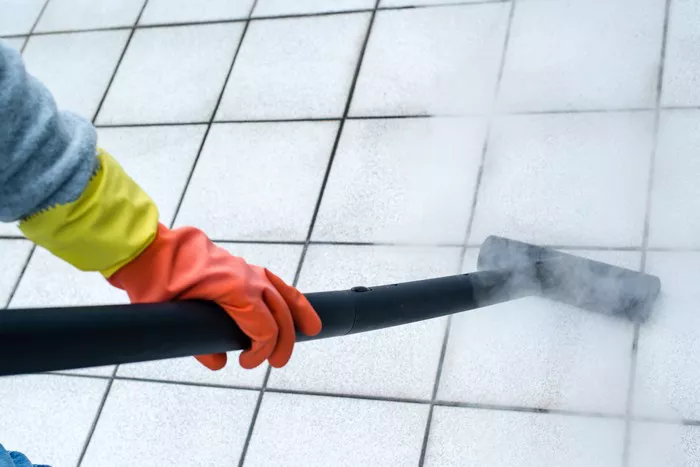For many homeowners, keeping tiles sparkling clean can feel like a constant battle. Grout lines trap dirt and grime, soap scum builds up in bathrooms, and kitchens see their fair share of greasy splatters. While traditional cleaning methods can be effective, steam cleaning offers a powerful and eco-friendly alternative.
This professional guide will equip you with the knowledge and techniques to achieve gleaming tiles through the magic of steam.
Why Choose Steam Cleaning for Your Tiles?
Steam cleaning offers a multitude of benefits that make it a compelling choice for tile care:
1. Disinfection: Steam’s high temperature effectively kills bacteria and mold spores, leaving your tiles hygienically clean. This is particularly important in high-moisture areas like bathrooms and kitchens.
2. Deep Cleaning: Steam penetrates deep into the pores of the tile and grout, loosening and lifting stubborn dirt, grime, and grease that surface cleaning might miss.
3. Minimal Chemicals: Steam cleaning relies primarily on water vapor for cleaning, reducing your dependence on harsh chemicals and their potential health risks. This is especially beneficial for households with pets or children.
See also: The Power of Steam: Understanding Steam Cleaners
Before You Steam: Choosing the Right Tools and Setting the Stage
Before unleashing the power of steam, a little preparation goes a long way:
1. Selecting a Steam Cleaner: There are two main types of steam cleaners to consider:
Canister Steamers: These larger units offer superior steam pressure and capacity, ideal for tackling large tile areas. They often come with a wider variety of attachments.
Handheld Steam Cleaners: These compact and lightweight steamers are perfect for smaller areas or spot cleaning. Their lower steam pressure may require multiple passes for heavily soiled tiles.
2. Attachments and Features: Look for a steam cleaner with attachments specifically designed for cleaning tiles and grout. These often include grout tools, steam jets, and various brushes (nylon for everyday cleaning and brass for stubborn stains). Adjustable steam pressure control allows you to tailor the cleaning intensity to the specific task.
3. Preparing the Area: Clear the floor or workspace of any furniture or rugs that could obstruct your cleaning. For walls, remove any pictures or decorations.
4. Pre-Cleaning: Vacuum or sweep the area to remove loose dirt and debris. This prevents the steam from simply spreading grime around.
The Steam Cleaning Process: A Step-by-Step Guide
Now that you’re prepped, it’s time to unleash the cleaning power of steam!
1. Tackling the Grout: Grout lines are notorious for accumulating dirt and grime. This is where you’ll want to focus most of your attention.
Attachment & Pressure: Use the grout attachment and adjust the steam pressure to a moderate setting. Avoid excessively high pressure, which can damage some grout materials.
Scrubbing Stubborn Stains: For stubborn stains, utilize a scrubbing brush attachment. Choose a nylon brush for everyday cleaning and a brass brush for heavily ingrained dirt. Scrub with gentle back-and-forth motions, working in small sections.
2. Cleaning the Tiles: Once you’ve tackled the grout, it’s time to steam clean the tile surfaces themselves.
Steam Nozzle: Glide the steam nozzle slowly and evenly across the tile surface. Overlapping strokes ensure thorough cleaning.
Sectional Cleaning: Work in manageable sections to ensure you don’t miss any spots and to allow for easier wiping up of loosened dirt.
Microfiber Cloths: As you steam, follow behind with a microfiber cloth to capture the loosened dirt and grime. Microfiber cloths are gentler on tile surfaces than traditional cleaning cloths and won’t leave streaks.
Drying and Finishing Touches
Drying Time: Allow ample drying time for the tiles after steam cleaning. Mold thrives in moist environments, so proper drying is crucial. Open windows or use fans to circulate air and expedite the process.
Buffing for Shine: Once the tiles are completely dry, buff them with a clean, dry microfiber cloth to achieve a beautiful polished finish.
See also: How to Deep Clean Carpets with Steam Cleaning
Additional Tips for a Sparkling Finish
Addressing Specific Concerns: For heavily ingrained grease or soap scum, pre-treat the area with a homemade vinegar solution (one part vinegar to four parts water) before steam cleaning. For mold growth, use a commercially available mold removal product according to the manufacturer’s instructions before steam cleaning the area.
Safety First: Always wear safety glasses and gloves when operating a steam cleaner. Never point the steam nozzle directly at yourself or others. Consult the user manual for specific safety precautions for your chosen steam cleaner model.
Regular Maintenance: Regular steam cleaning helps prevent dirt and grime buildup, making future cleaning sessions easier and faster. Aim to steam clean your tiles at least once

